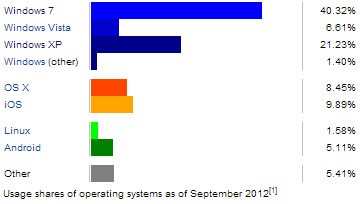2012 Malware Infection Rates Soar to New Highs for Windows 7
It used to be a time when security researchers concluded that Windows XP was the most vulnerable operating system around. As that testament may hold true depending on who you talk to, Windows 7 is taking the stage for soaring malware infection rates during this year (2012).
You do not have to be a security expert to realize that Windows XP remained in the security spotlight ever since its release back in 2001. With Windows 7 being on the market for just over 3 years now and currently being the choice operating system for PCs, it has become the likely candidate for malware infections at an alarming rate.
According to Microsoft's latest twice-yearly security report, the likelihood of Windows 7 becoming infected by malware during the second quarter 2012 is between 33% to 182% more likely than during the same time in 2011. So far, Microsoft has blamed this increased infection rates to a boost in successful malware attacks and less savvy users. Sure, that may seem like a blanket statement, but in reality there are many factors that play into Windows 7's astonishing infection rates this year.
One thing to note about Windows 7 being in the limelight for growing malware infections is that Windows 7's popularity has a lot to do with everything. Looking at statistics from many sources, you will come to the conclusion that Windows 7 is the most widely used operating system when it comes to actual computers. As an example, usage statistics relayed by Wikipedia (Figure 1.) show Windows 7 having over a 40% usage where Windows XP falls in second place at just over 21% followed by Apple's mobile iOS operating system.
Figure 1. Operating system statistics on Wikipedia

When pressed with an explanation of Windows 7's recent growing malware infection rates, Microsoft spills the following justification.
"This may be caused in part by increasing acceptance and usage of the newest consumer version of Windows," said Microsoft in its latest Security Intelligence Report. "Early adopters are often technology enthusiasts who have a higher level of technical expertise than the mainstream computing population. As the Windows 7 install base has grown, new users are likely to possess a lower degree of security awareness than the early adopters and be less aware of safe online practices."
To reside on Microsoft's side, Windows 7 still is an improvement over Windows XP when it comes to security and vulnerabilities that lead to dangerous malware infections. Another factor to consider is the idea that Windows 7 is the first operating system platform to be adopted by both consumers and enterprises.
Hackers, cybercrooks and attackers, follow the market and they do it well. With that said, many of these crooks work smarter instead of harder by populating the techie world with malicious threats that attack the most popular platforms. Why waste ammo on small Apples in a large field when you can shatter large Windows? Pun intended.
Figure 2. Microsoft Security Intelligence Report 2012 Malware Infection rates per thousand PCs chart

There is no doubt that Windows in general is a large target for cybercrooks and hackers. In following the market changes, the release of new service packs and software patches for Windows brings about changes in infection rates. The Microsoft Security Intelligence Report chart above (Figure 2.) demonstrates malware infection rates per thousand PCs based on specific Windows operating system versions (service pack classified). You could easily determine how specific versions of Windows 7 have basically risen to the occasion as its popularity and updates took root.
Either way you put it, malware creators will find a way to be a driving force to be reckoned with when it comes to attacking a widely used platform. Windows 7, with its current overbearing popularity, may very well over-take Windows XP SP3 as the reigning king of malware infection rates. Until then, guard yourself accordingly and never take malware for granted no matter which operating system you use.
Leave a Reply
Please note that we are not able to assist with billing and support issues regarding SpyHunter or other products. If you're having issues with SpyHunter, please get in touch with SpyHunter customer support through your SpyHunter . If you have SpyHunter billing questions, we recommend you check the Billing FAQ. For general suggestions or feedback, contact us.